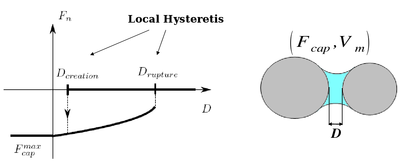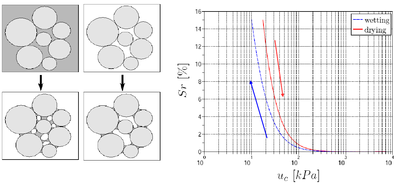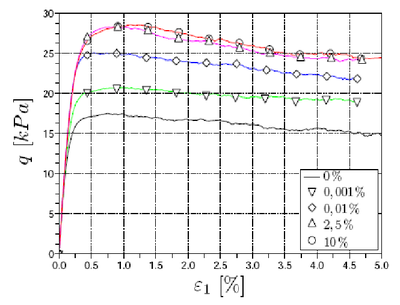CapillaryTriaxialTest
From Yade
Modelling granular materials with capillary forces
Capillary effects are taken into account as a result of capillary bridges between each pair of spherical elements based on the resolution of the Laplace-Young equation (http://en.wikipedia.org/wiki/Young–Laplace_equation). Be careful, the formulation is valid only for pendular menisci involving two grains (the so-called "pendular regime"). At the scale of an assembly, the corresponding degrees of saturation are therefore limited to low values (typically, between 0 and 15%). An algorithm has been developed by B. Chareyre to identify menisci overlaps on each spheres (menisci fusion). Some basic assumptions can be made to reduce capillary forces when menisci overlap (binary->Fcap=0 if at least 1 overlap, linear->Fcap=Fcap/numberOfOverlaps), but this is purely experimental.
The control parameter is the capillary pressure (or suction) Uc, defined as the difference between gas and liquid pressure: Uc = Ugas - Uliquid. Liquid bridges properties (capillary Force Fcap, volume V and extents over interacting grains delta1 and delta2) are computed as a result of the defined Uc and the interacting geometry (spheres radii and interparticular distance).
For more documentation, have a look at:
1 - L. Scholtes, PhD thesis -> http://tel.archives-ouvertes.fr/tel-00363961/en/ (a lot of details but in french)
2- Scholtès, L., Chareyre, B., Nicot, F., Darve, F. (2009), Micromechanics of granular materials with capillary effects. International Journal of Engineering Science (47), pages 64–75. DOI 10.1016/j.ijengsci.2008.07.002
3 - Scholtès, L., Hicher, P.-Y., Chareyre, B., Nicot, F., Darve, F. (2009), On the capillary stress tensor in wet granular materials. International Journal for Numerical and Analytical Methods in Geomechanics (33), pages 1289–1313. DOI 10.1002/nag.767
4 - Scholtès, L., Chareyre, B., Nicot, F., Darve, F. (2009), Discrete modelling of capillary mechanisms in multi-phase granular media. Computer Modeling in Engineering and Sciences (52), pages 297–318. DOI ` <http://dx.doi.org/>`_
To run the simulations, you have to download this File:Capillary.gz and extract the content to your yade/bin folder (where the yade executable is). You should end with 10 text files in /bin. CapillaryLaw will read those files once at startup and use the data to interpolate capillary forces for arbitrary cases. If yade is started from another path, then the files should be in this path.


